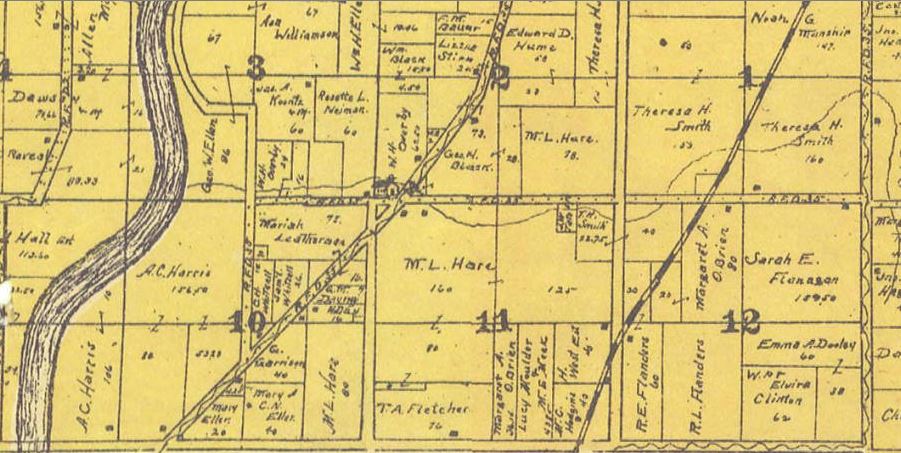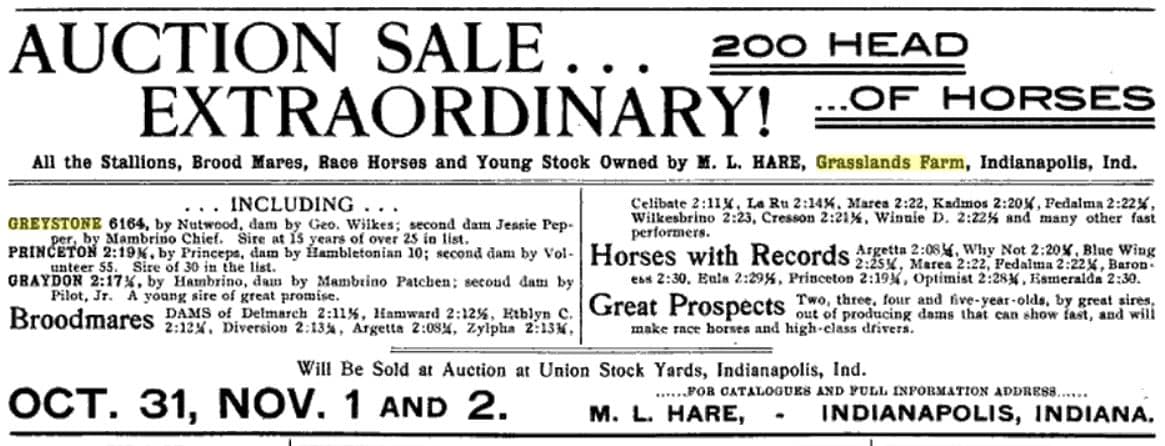 Marcus L. Hare and Grasslands Farm
Marcus L. Hare and Grasslands Farm
By: David Heighway, Hamilton County Historian
To follow up on the trotting horses I discussed in the last post, this is a look at one of the most famous horse breeders and horse farms in Hamilton County. It has special significance because of the recent changes at Hare Chevrolet. It turns out there was another member of the family that was also involved in the transportation business, albeit more concerned with speed – Marcus Lafayette Hare.
Wesley Hare, the well-known patriarch of the wagon-building business, had an older brother named Daniel, who had been born in 1814. He moved to Noblesville with the family, married in 1838, and his son Marcus was born in 1839. Marcus’s mother died when he was two and Daniel remarried. Marcus’s father and stepmother both then died in the 1850 Hamilton County cholera epidemic and he was presumably raised by other family members. He married in 1859, briefly served in the Civil War, and moved to Indianapolis in 1864.
By the 1870’s, he had begun his horse breeding business. He had always been Interested in fast horses – in March of 1871, he had been fined $4.65 by the Indianapolis City Court for fast driving. In 1875, Hare returned to Hamilton County to establish a horse breeding farm called Grasslands Farm in Delaware Township. A year later, he bought a seven-year-old horse that he would name Hambrino. This horse would turn out to be the first in a long line of famous trotters.
Hambrino began to establish his reputation in the late 1870’s. He made an excellent showing at in Ohio in 1878 that was well coved in the newspapers. During a successful tour of the east coast in 1879, he would set a personal record time of 2:21 ¼ in Connecticut in August and was mentioned in the New York Times on September 17.
It’s exciting to read about the races, since the newspaper would do a recap of the entire race, including crashes. They would discuss strategies, problems and controversies, much like sports reporting today. A person familiar with harness racing could probably reconstruct Hambrino’s style and strengths. Hambrino retired from the track in 1883 and was put out to stud. After a short stay at a farm in Kentucky, he spent the rest of this life at Grasslands Farm. He was considered the premier breeding horse at the farm.
Marcus Hare was a part of the regular sales held at the Indianapolis Stockyards and Grasslands Farm would be mentioned prominently in the advertising. At one sale on a bitterly cold day in March of 1888, the bidding wasn’t going well, so he stepped up to help the auctioneer. He had a good rapport with the crowd, making jokes like: “You fellows wouldn’t buy gold dollars if they were selling for three cents each” and “She’s blind in one eye and can’t see very well out of the other, but she’s a good one.” In the end, most of the horses were sold.
An 1889 article said that Grasslands Farm had 600 acres, 100 head of horses with stable room for 200, and a mile track for training. We know the names of some of the farm trainers: 1891 – Louis Ziegler, 1892 – Mr. Bryant, 1893 – Ben Walker. People were very proud of the farm’s reputation. For example, in 1893, a Boston horse breeding journal referred to one of the farm’s prize horses as being “short-bred”, which apparently meant that it did not come from a long line of winning horses. The Indiana State Sentinel newspaper responded with a listing of the horse’s heritage and sarcastically stated, “…our friend in the bean-eating district is not supplied with the necessary documents to enable him to write accurately as well as entertainingly…” Hambrino died in 1895 and a horse named Greystone became the premier breeding horse.

The first decade of the twentieth century was a difficult time for Marcus Hare. Many of the Grasslands Farm horses were sold off in a big sale in fall of 1901, supposedly to close down the farm. However, it continued to stay in business and hold regular sales. Hare was severely injured in October of 1903 trying to stop a runaway horse. He had been waiting for streetcar in Indianapolis when he saw it running down street. He stepped in front of it to stop it, but struck and knocked unconscious. He had a concussion and was in critical condition for a few days. He was finally declared out of danger on November 11, but was never in good health after that. His son, Clinton Hare, died in June of 1909 after a long illness. Then the horse Greystone died in October of 1909. A lightning storm killed two horses and destroyed a barn on August 18, 1911. Finally, Hare himself died on August 30, 1911, of diabetes and complications of his earlier accident.
Grasslands Farm continued to run and was still hiring farm hands in 1917. It was owned by the Hares as late as 1933, but by 1949 the property had been sold to the Gatewood family. In 1960, David Gatewood used the land to establish the airport that is the Indianapolis Metropolitan Airport today. (The section with Richey Woods had always belonged to someone else.) There is no trace left of Grasslands Farm today. But it is fitting that the land is still involved in transportation.
